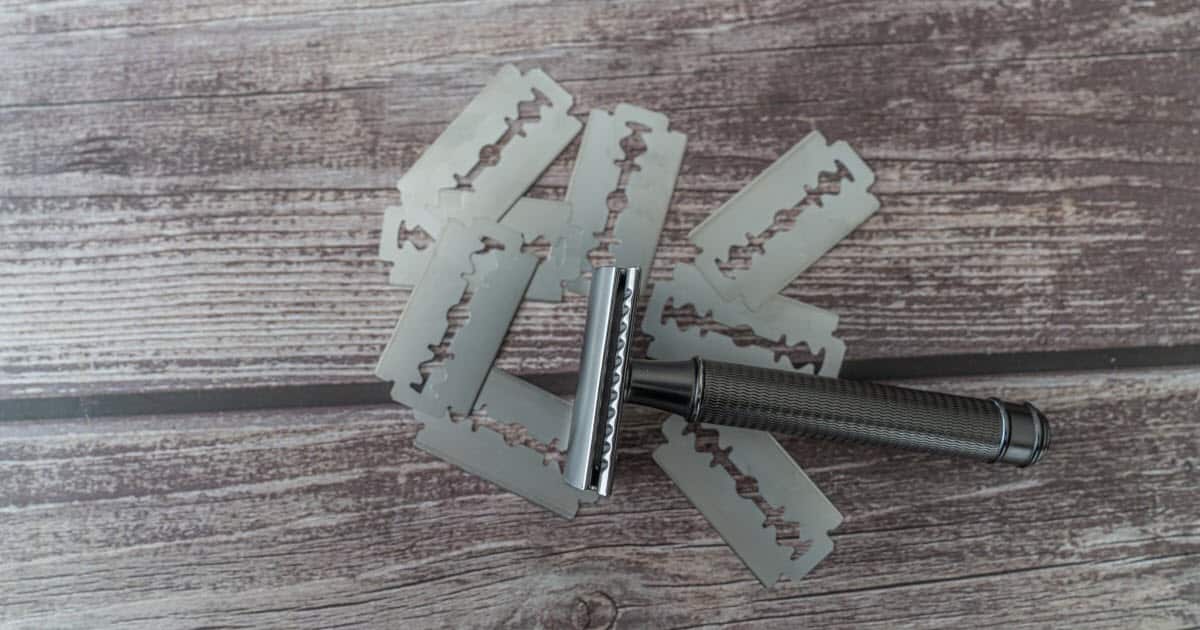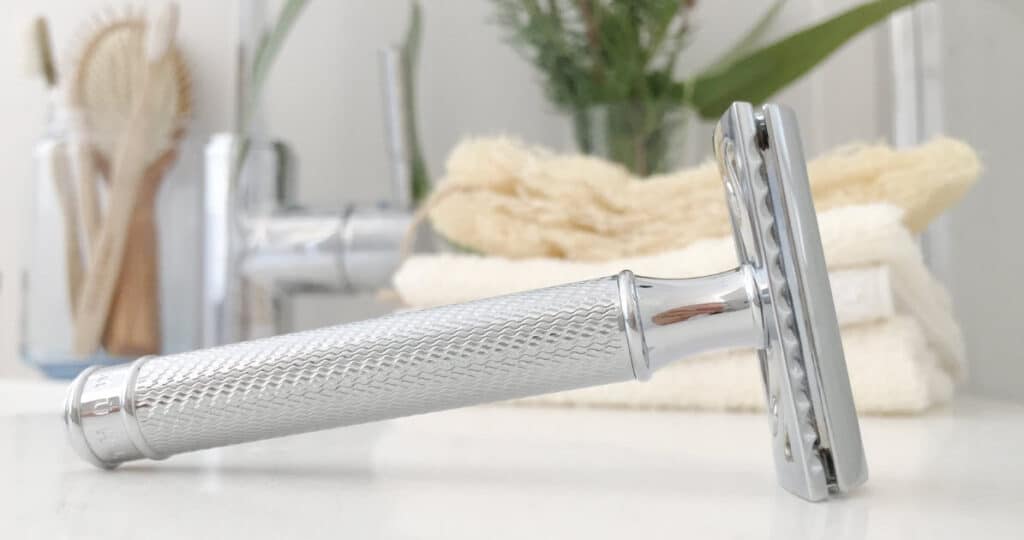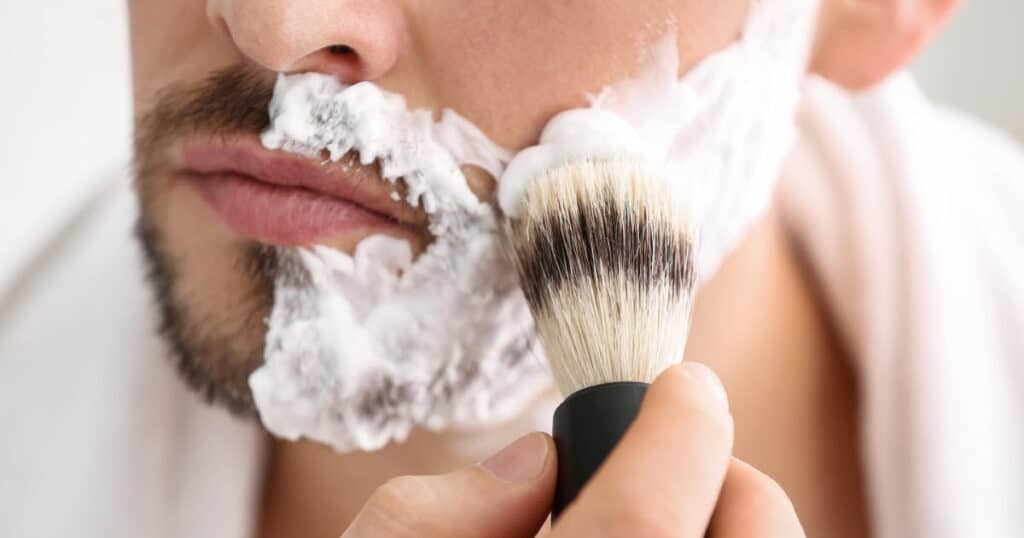Razor blades: pretty much every adult, man and woman alike, uses them. But where do you put them after you’re done? Can they be recycled? Are they going to hurt someone after you’ve disposed of them? These are very common questions, and believe it or not, there’s not too much information about how to recycle razor blades.
In today’s article, we’ll take a look at some of most common concerns when it comes to razor blades, recycling, and disposal, and discuss options for both men and women who use razors to remove unwanted body hair.

Some History
Once upon a time, when both women and men used safety razors, medicine cabinets used to have a small slit in them where shavers could dispose of their old razor blades. This was the kind of old-school, “out of sight, out of mind” solution that you don’t see too often these days, for two reasons: 1) If whoever took down that medicine cabinet wasn’t aware that there were hundreds of deadly razor blades waiting to pop out, he or she would have quite a problem, and 2) People gradually switched from using straight razors and safety razors to using disposable razors and cartridge razors, all of which could be tossed in the trash after use. So the “medicine cabinet as razor trash can” idea isn’t too common anymore, and now people who use disposable razors simply discard them after a few uses.
Here’s the problem:
Using a disposable razor is, far and away, the least environmentally-friendly way to remove hair from your body. In other words, using a disposable razor is a really, really bad for the earth. The EPA (Environmental Protection Agency) estimates that more than two billion disposables razors are used and tossed away every year, and that’s just in a single year. All of those razors get dragged to landfills, where they sit for thousands and thousands of years. That’s pretty awful.
So what do you do with razors after you’re done using them? How can you shave and be eco-friendly?
Your Options
Sadly, there is no 100% green way to shave (unless you’re using some kind of sharpened stone, caveman-style, and we don’t suggest that). There are, however, “levels of greenness” when it comes to shaving. We’ll go from what seems to be the least-green way to shave to the most-green way to shave.
The Least Green Option: Disposable Razors
As we mentioned above, these are… not great. Most products that are labelled “disposable” might as well be labelled “Eventually Pollutes the Earth for Thousands of Years.” Disposable products can be hugely beneficial (one-use medical products, for example, reduce the likelihood of viruses and bacteria spreading), but many of the most common household products—razors, toothbrushes, unrecyclable plastic products—get thrown in the trash and forgotten about in a rubble heap somewhere. Most disposable items don’t decompose, and if you think about the billions of people, creating trash every single day, it’s a wonder we’re not in it up to our eyeballs.
So, disposables aren’t a good green option. They’re either made from a plastic that’s not recyclable, or the plastic is recyclable but recycling centers don’t want to take them because they still have razor blades in them. There is, however, a disposable razor company called Preserve that sells recyclable razors, with a program underway that allows disposable users to return old razors, called Gimme 5, but they’re pretty much a pioneer at this point. If you want to go green, disposable razors are probably not the best way to go.
A Better Option: Safety Razors
When you invest in a quality safety razor, you will simply use less of the earth’s materials, period. You buy the device’s handle and head, and all you need to do are purchase paper-thin razor blades to shave with. With proper maintenance, you keep the handle and the head for your entire life, and simply buy new blades (which, by the way, are very very cheap—over time, using a safety razor will save you a TON of money, compared to using disposables).
For the longest time, safety razors were kind of a “throwback” item. They were widely used in decades past, but began to seem somewhat antiquated after the emergence of disposables. That, however, has changed in recent years, and we’ve seen a steep incline in popularity of wet shaving over the last couple of years. There are dozens of websites that discuss different types of razors, razor blades, products, and shaving techniques, and men currently seem to be very interested in returning to shaving methods of the past.
(One quick note: common knowledge says that safety razor shaving and wet shaving in general is something that only men do, but that is NOT the case. We get into this a little more explicitly below.)
Next up in our “how to recycle razor blades” discussion:
A Surprisingly Green Option: Electric Razors
Somewhat surprisingly, electric shavers are a very very green option: believe it or not, when it comes to being eco-friendly, whether you can recycle razors is only *one* of the most important issues of concern. The other important issue is water usage. The amount of water used by the average shaver—as well as the power used to heat that water—contributes to the shaver’s environmental impact, and electric shavers tend to use less water than traditional “shaving blade” methods. Who knew!
There is, of course, the issue of creating the electricity used to power the electric shaver, but the environmental impact of that electricity can be offset somewhat by using cold water to rinse.
Straight Razors: The Green Man’s Dream Tool
These may be the absolute greenest way to shave hair from your body. Above, we mentioned that with safety razors, you buy the handle and head, and then simply buy replacement blades. With straight razors, you buy the tool, and replace nothing, for years: the entire device is a blade, and you can use a well-maintained straight razor for the rest of your days. You’ll need to watch the amount of water you use during a shave, but aside from that, a straight razor is an earth-lover’s dream tool for hair removal.
These can be difficult to use, and there’s certainly a “transition period” where you’ll get a lot of nicks as you start out, but they are a very green way to shave.
How Do I Get Rid of My Safety Razor Blades?
So maybe you’ve decided to ditch the disposables, and decided to try wet shaving with a safety razor. Good for you! Now that you’ve decided to use a safety razor, you’re probably wondering where to ditch your old razor blades.
You can get rid of them in a thing called a “blade bank.” These are little receptacles that are specifically made to be little trash cans for old razors. They include a little slit at the top, so razor blades go in, and don’t come back out. They’re structurally sound, too, so they won’t get crushed and have the blades leak out.
If you think about it, blade banks are a really, really good idea: even rusty blades are sharp enough to cut through skin (and to do so in a jagged way, if they’re blades that have been used a few times), and tossing them in the rubbish bin is dangerous for anyone in your house or apartment (such as kids or pets or whoever cleans the room), and they’re dangerous for the men and women who handle the trash after we’ve disposed of it. Having a specific, safe location to toss old razors and then recycle them is important.
The fascinating part is, if you use a blade bank, you’re basically using a little recycling center. You’ve collected all of your old steel razors in the same place, and when the bank is full, you can contact your local recycling center and see if they will accept razor blades. If not, you simply toss your blade bank in the garbage, and rest easy knowing that the blades won’t injure the trash removal professionals who take your garbage away, because they’re safe within the blade bank.
There are some models you can buy (West Coast Shaving has a very simple one), but you can make your own, as well. These can actually be really interest art projects—when you create your own blade bank, you can decorate it any way you like.
Not Just for Gents
Far and away, most of the posts on our site are aimed at dudes, or, at least, people who want to shave their faces and/or talk about beards.
But! This post (and particularly this section) is for women. Believe it or not, there are a LOT of women who remove the hair on their legs and under their arms by safety razor shaving and straight razor shaving.
Check it out—here’s a video of a woman guiding other ladies through the entire process of shaving her underarms with a safety razor (and this video has almost a half-a-million views), as well as a woman shaving her legs with a straight razor, which, by any standard, is pretty hardcore.
Here’s the lady with the straight razor:
…and here’s the lady removing armpit hair with the safety razor:
If You’re Currently Using a Disposable…
If you’ve strolled around our site, you may have noticed that we are fairly obsessed with the benefits of wet shaving with a straight razor or safety razor. We do our best to convert the unconverted, and spread the message of wet shaving to those who haven’t heard it, because it’s benefited our lives so tremendously.
That said, we understand that there are still many, many men who prefer to use a disposable razor. To each his own, we say! It’s our opinion that shaving with a straight or safety razor is a far, far more pleasant experience than shaving with a disposable, but we respect the right of absolutely everyone to do their own thing. More power to you.
That said…
If you use disposables and you want to be greener, we’d suggest you research wet shaving. There are dozens of fantastic wet shaving websites, and hundreds (if not thousands) of wet shaving tutorials on YouTube. Go ahead and see what all the noise is about—you may find that not only do you enjoy wet shaving, but your grooming habits have become much more green.
If You’re Not Green and You Can’t Find the Motivation to Get Green…
Let’s be honest: we all have a friend or two who are, let’s say… “militantly green.” If you forget to recycle something, you get an earful, and if you hint that you don’t know what each of the plastic recycling symbols mean, you’re in for a lesson.
And—God bless those folks! They’re intense, but their message is super important.
On the other end of the spectrum, there are a lot of guys who want to do right by the Earth, but aren’t as motivated. They want to help, but don’t want to become militant about things.
If that’s you, that’s OK! Take baby steps, and start by going “light green.” Make a couple of small adjustments in your life, and enjoy the change you’ve made. You can start by wet shaving and recycling your old razor blades, or by buying a couple of reusable grocery bags, or by getting a reusable water bottle and skipping the water bottled in plastic. It’s super-easy to implement small habits like this, and they make a HUGE difference to the environment.
But if you need some motivation on why need to take care of our planet, spend some time in our National Parks. Seriously. They are unbelievably, unimaginably beautiful, and you will be moved by them when you visit. From Sequoia National Park in California to Acadia National Park in Maine, our National Parks are a treasure beyond compare, and some Americans make it a life goal to visit all of them. It’s almost impossible to walk through them and not think, “Yeah, we need to take care of all this.”
Final Thoughts on Recycling
To sum up… the issue of recycling razor blades is a little complicated! It’s not as simple as, say, glass bottles, which go right in the recycling bin. You’ll need to either use disposable blades that are specifically made to be recycled, or use safety razors and then contact your local recycling center to see if they’ll take them, or simply find the shaving method that uses the least amount of natural resources, and make that your daily practice. Whatever you do, thank you for being good to the Earth! We’re all in this together, and we need to do what we can!
Michael Morris is the head writer here at Rough and Tumble Gentleman. He's got a ducktail beard and loves Brazilian jiu-jitsu. He's married to the woman of his dreams and lives in Brooklyn, NY.




